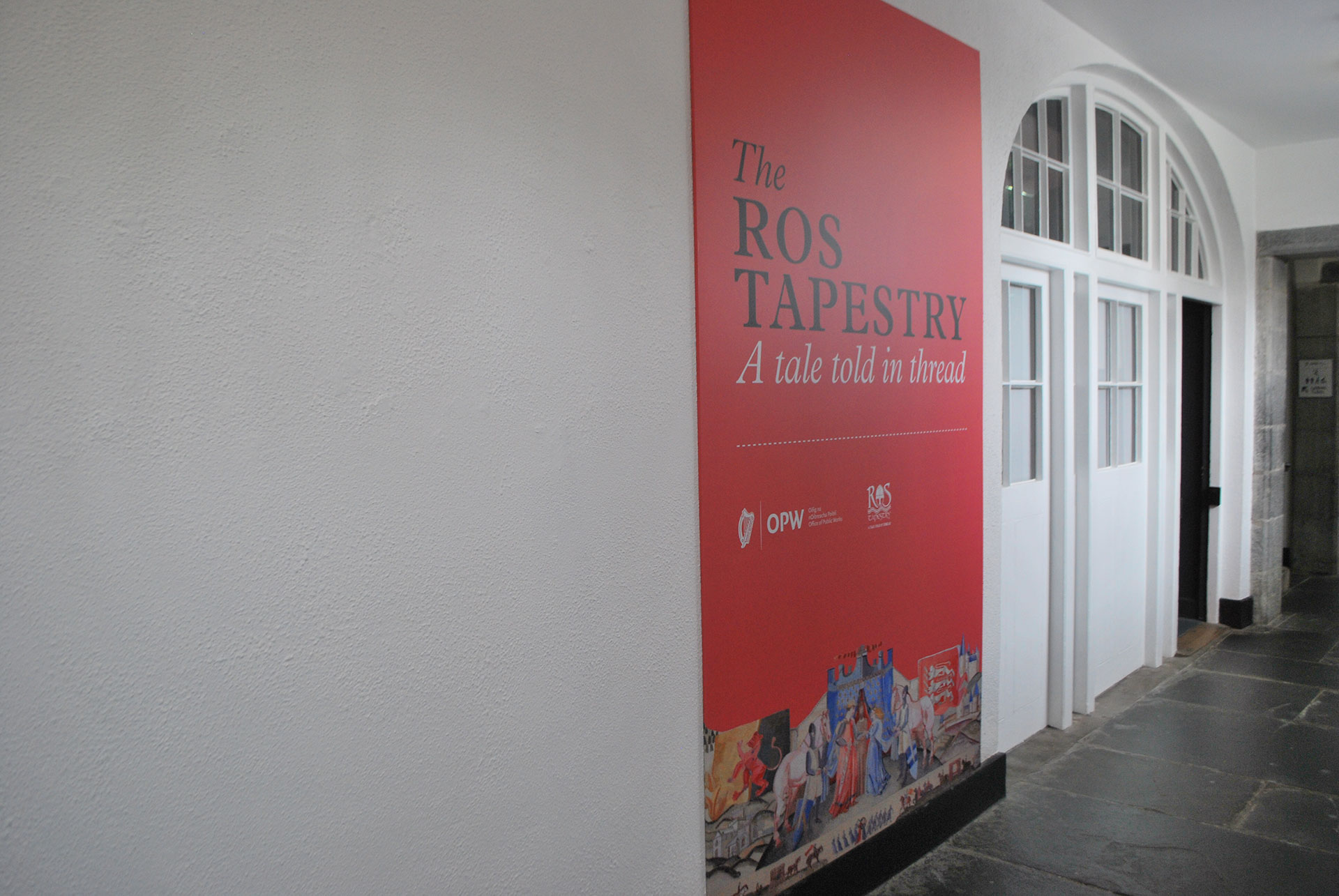Welcome to the Ros Tapestry
One of Ireland’s Greatest Treasures

Photo Credit: Mary Browne
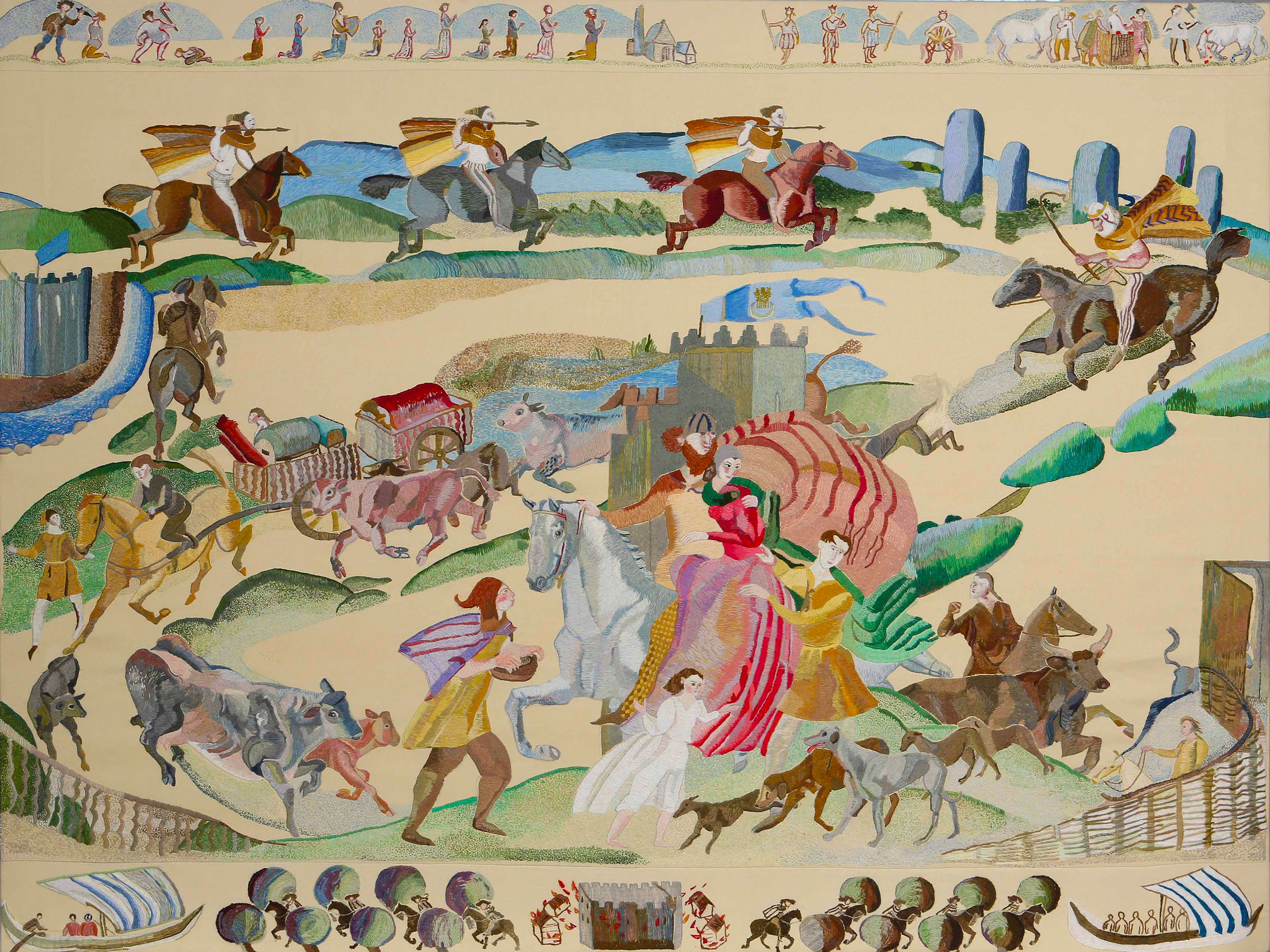
Photo Credit: Mary Browne
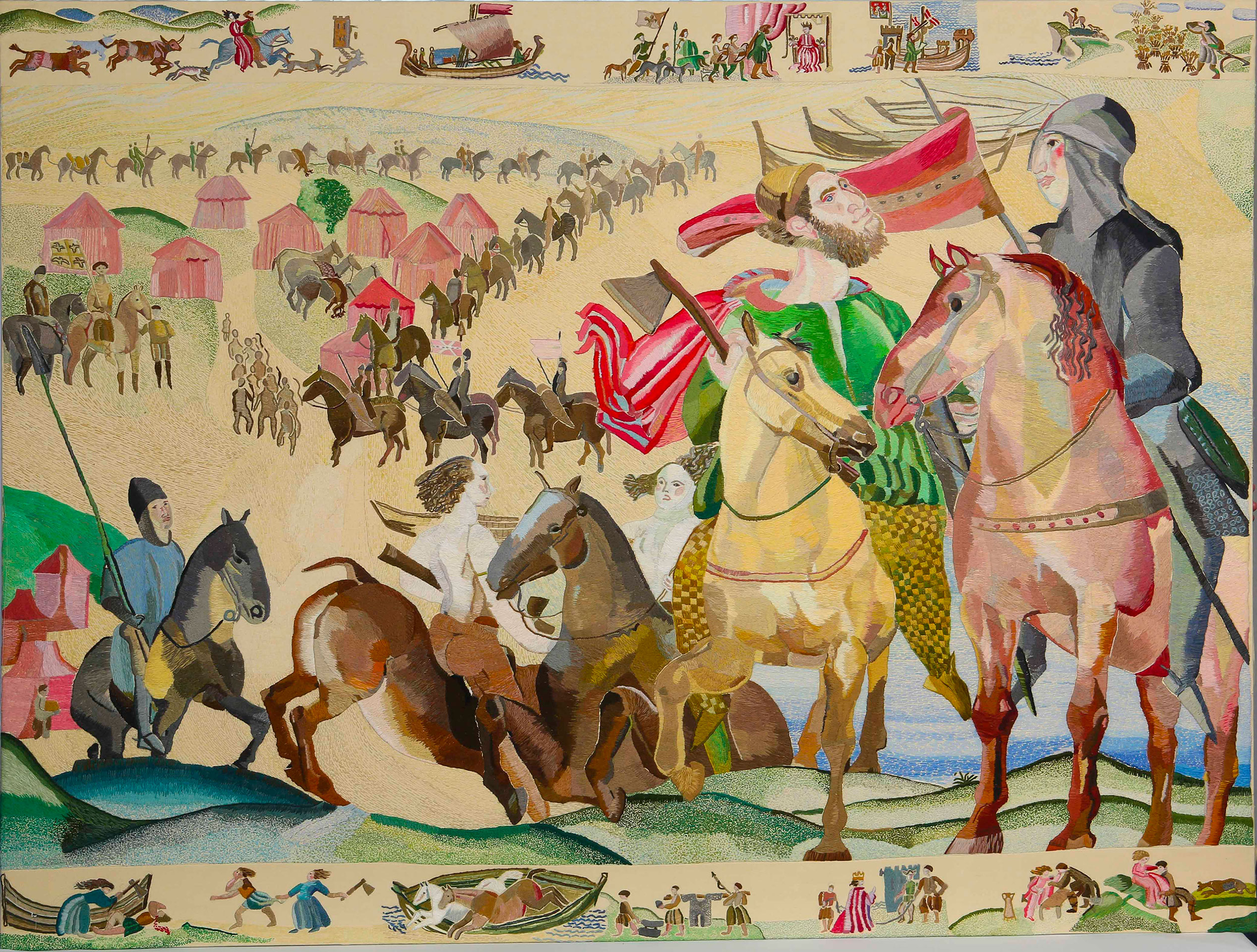
Photo Credit: Mary Browne
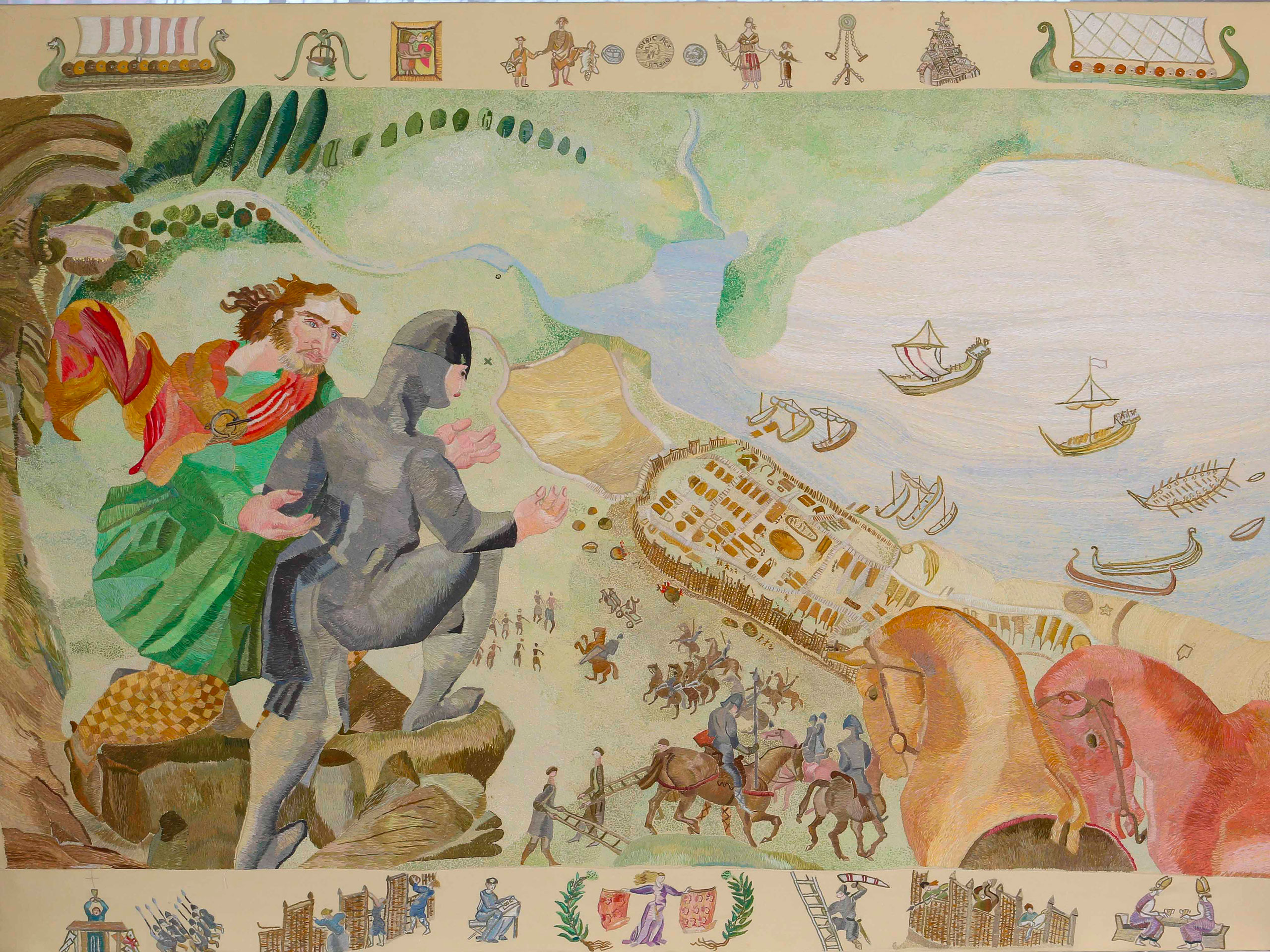
Photo Credit: Mary Browne
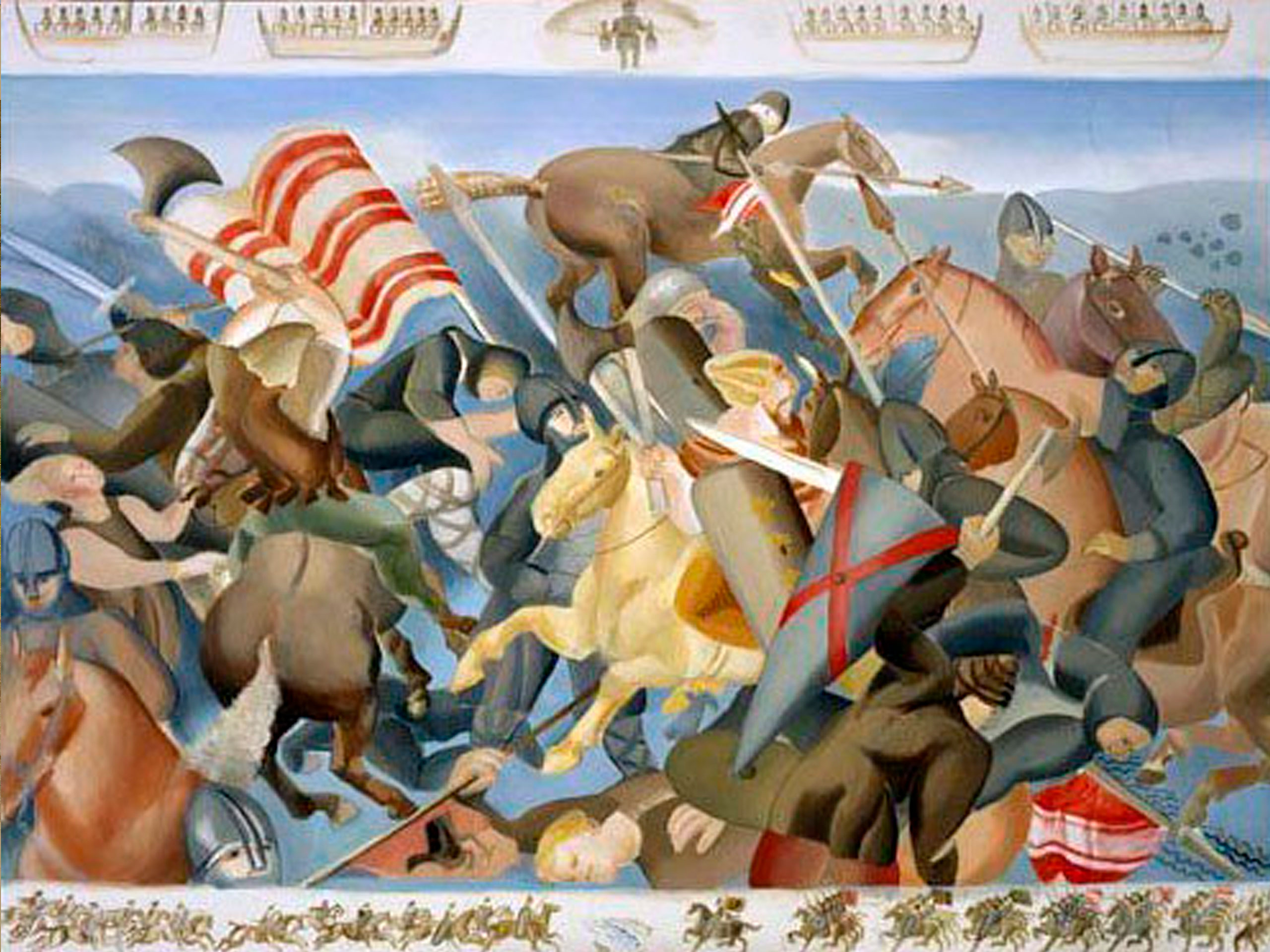
Photo Credit: TBC

Photo Credit: Mary Browne

Photo Credit: Mary Browne

Photo Credit: Mary Browne
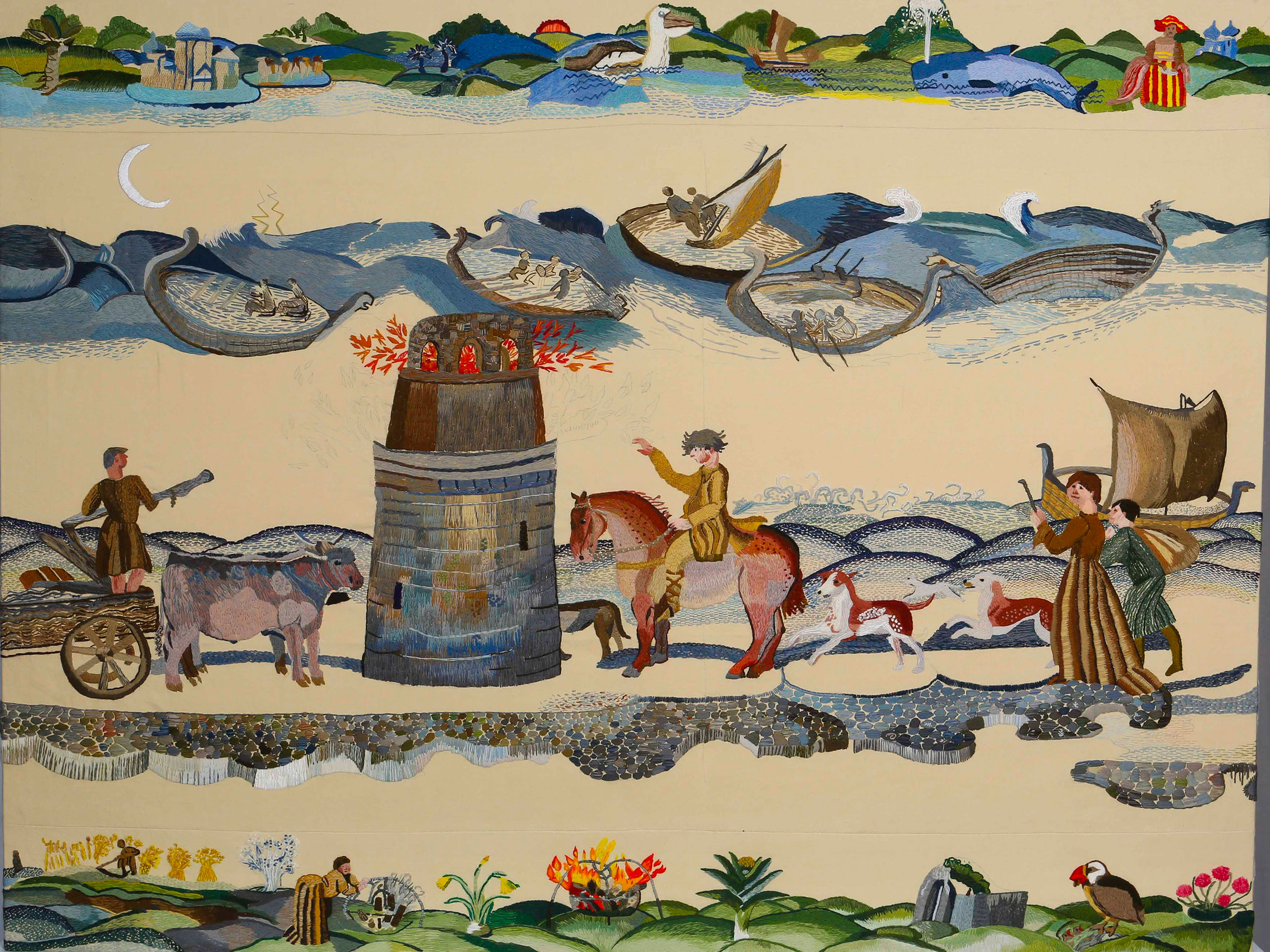
Photo Credit: Mary Browne
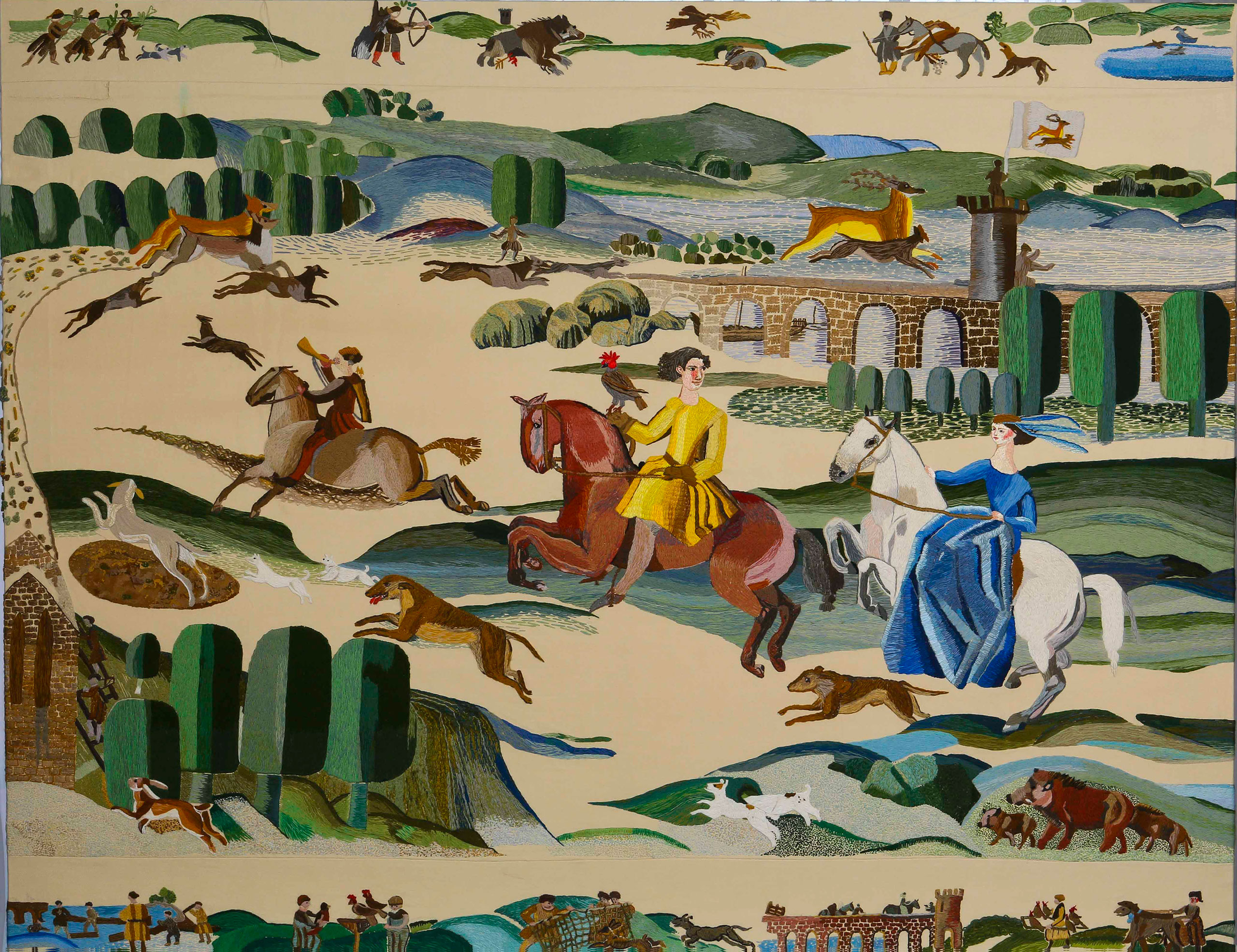
Photo Credit: Mary Browne
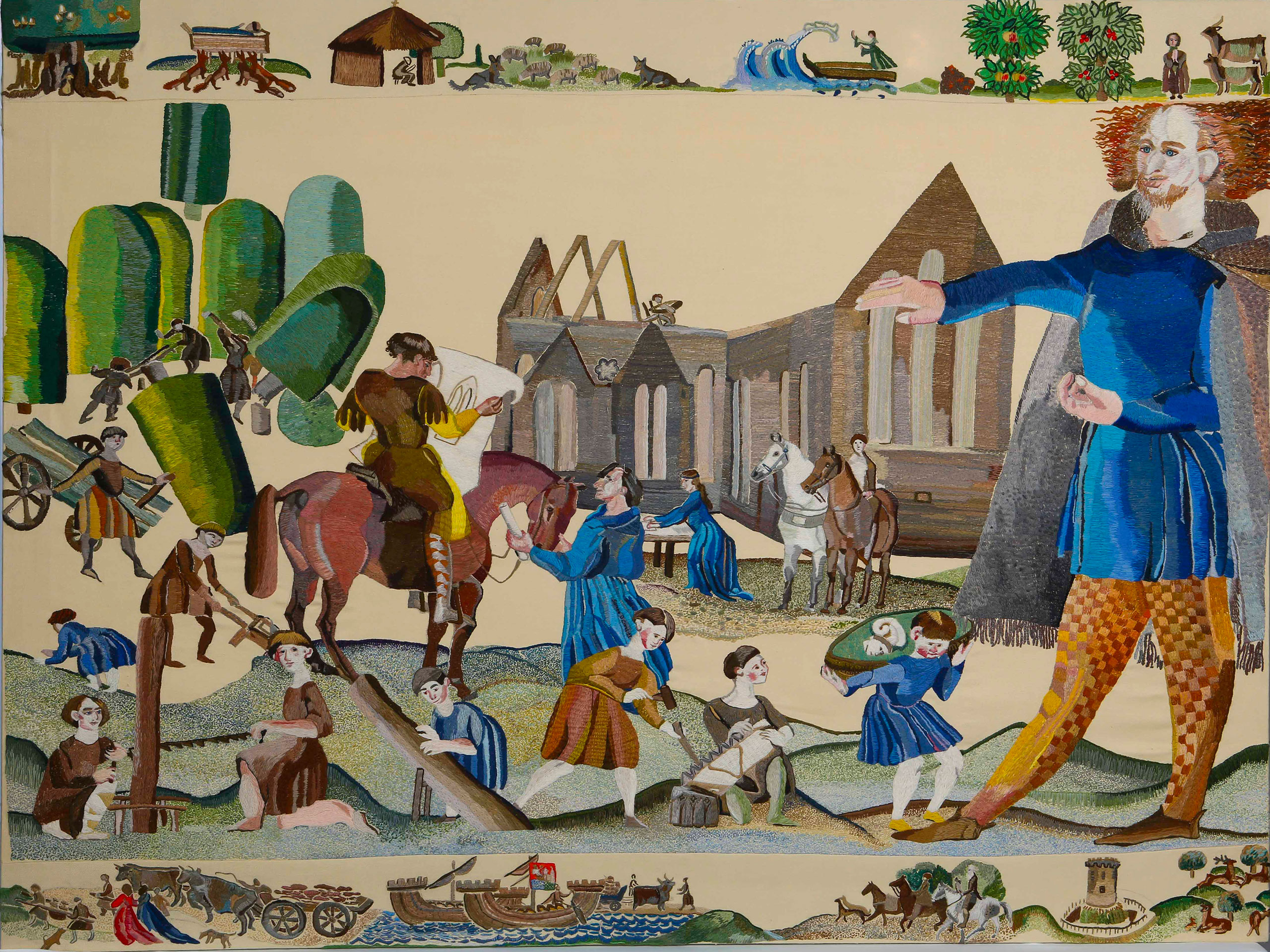
Photo Credit: Mary Browne

Photo Credit: Grace Hall

Photo Credit: Grace Hall

Photo Credit: Grace Hall
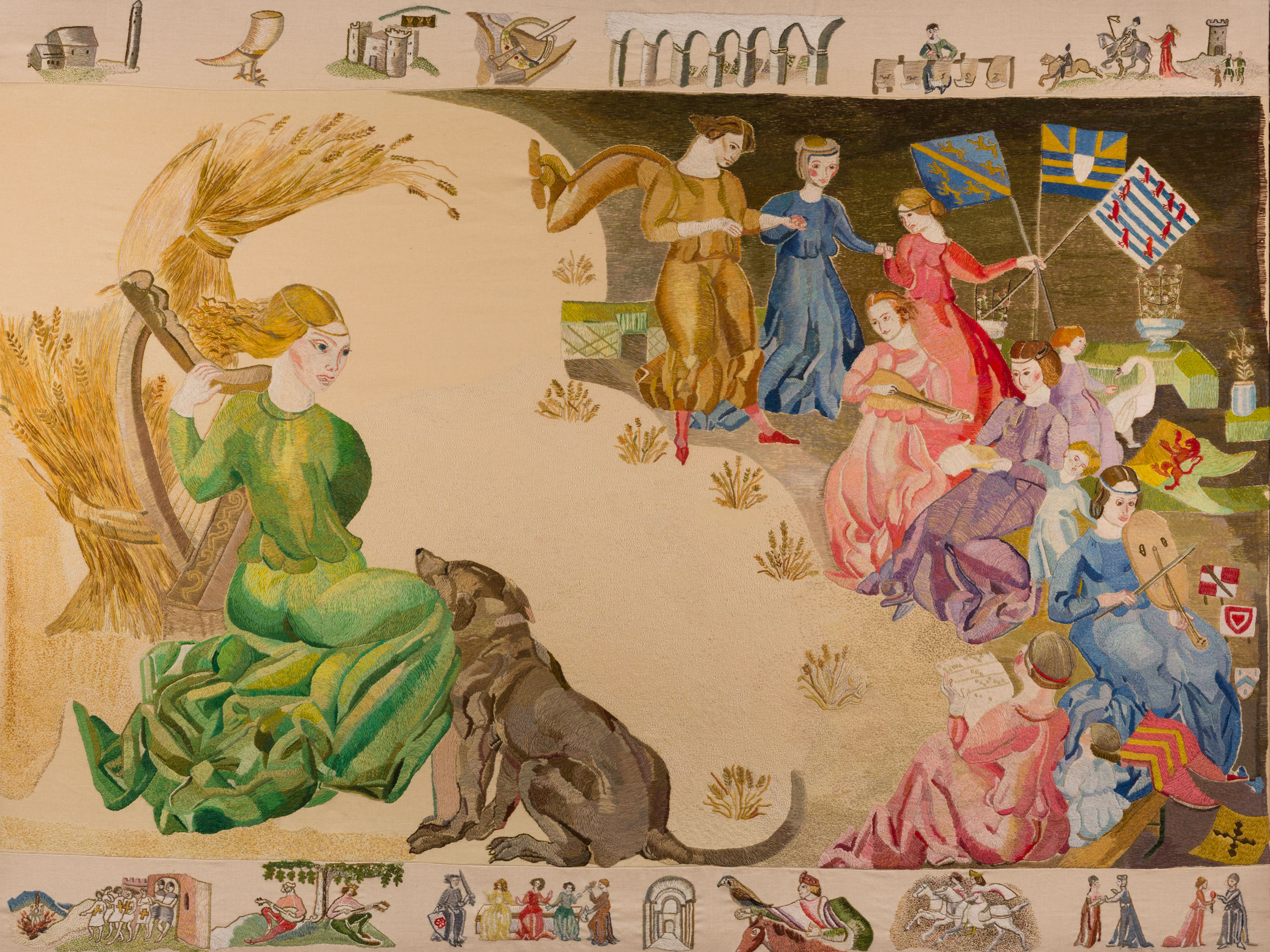
Photo Credit: Grace Hall
THE CELTS: AN ISLAND FASTNESS
PATRON: DR.PATRICK MURPHY
In 700 B.C. Ireland was covered in oak forests and inhabited by the Celts. They lived by Brehon laws and Celtic customs, still in force in the 12th century. The main section of this panel shows the ritual coronation of a Celtic King, presided over by a Brehon Druid, and watched by the warriors with their chariots. The ceremony involved a symbolic union between the King and a pure white mare - the union of the earthly and the divine.
The top border shows Celtic symbols such as women warriors, the brown and white bull of Queen Maedbh and the Brehon punishment. The lower border depicts aspects of early Christian Ireland - St. Brendan sailing to America, a decorated gold chalice and book shrine, St. Bridget with her cross, and the door of Clonfert Cathedral showing evidence of the Celtic preoccupation with sacred heads.
Started in 2005. Completed in 2009
Stitched at the home of Phil Pearson in The Deeps, Crossabeg, and Johnstown Castle
Stitched by: May Carty, Eileen Cowman-Coughlan, Ann Duggan, Tess Dunphy, Avril Harvey, Gillian Hearn, Patricia Jones, Mary Kidd, Mary McDonald, Margaret O’Dowd, Phil Pearson, Peggy Rossiter, Eithne Scallan, Josephine Carey, Ann Kierans, Niamh Tierney, Charlotte Warham, Joy Fletcher, Mary Somers, Geraldine Barry, Patricia Baynes, Maureen Clarkin, Sinéad McGlynn Parks, Alice Turner-McElween.
- Symbolic union of the King and his white mare, who represents the Earth Goddess, to ensure that she will smile on his reign.
- Druid presiding at the ceremony and holding a white wand
- Upper border depicts Celtic women soldiers, the brown bull and white bull of Queen Madhb and her husband, a criminal facing Brehon punishment
- Lower border depicts St Brendan sailing to America, St Bridget with her cross, the door of Clonfert Cathedral and its sacred heads
THE ABDUCTION OF DERVORGILLA
PATRONS: PADDY & PATRICIA QUINN
In 1153, Dermot MacMurrough, High King of Leinster, who resided in Ferns castle, abducted Dervorgilla. She was the wife of his enemy Tiernan O'Rourke, King of Breffni. He brought her from the O’Rourke castle in the west of Ireland to Ferns in Wexford. Brehon tradition allowed her to take her dowry with her if she wished to leave her husband. For his impudence, Dermot was fined a ransom of 100 ounces of gold. More seriously, two of his sons were held hostage pending payment of this ransom. O'Rourke formed a coalition to oust Dermot from his kingdom when this ransom was not paid.
The top border shows the harsh reality of life in Celtic times. Dermot's son Eanna was blinded, and another son beheaded because of the actions of their father. The lower border shows Dermot's allies fleeing Ferns. Dermot set fire to his castle rather than allow it fall into the hands of his enemies.
Started in 2004. Completed in 2007
Stitched at the home of Ann Mackey at Effernogue in Ferns.
Stitched by: Teresa Hiney, Ann Mackey, Joan Morris, Anne Peppard
- Dermot and Dervorgilla galloping away from the O Rourke Castle in Roscommon
- Dervorgilla’s dowry - her cattle and household chattels
- The King of Breffni, Tiernan O Rourke, in pursuit
- A ghost from the future, Dermot’s daughter, Aoife, not yet born
- Upper border depicts Dermot, aged 16, being installed as King of Leinster, the decapitation of Dermot’s heirs by Rory O Connor, the High King of Ireland
- Lower border depicts the O Briens of Duffry scattering as Dermot burns Ferns
ARROGANT TRESPASS: THE NORMANS LANDING AT BANNOW STRAND
PATRON: DR BRIGID O’ CONNELL and DR CONOR BURKE.
Ousted from his Kingdom, Dermot was left with little option but to seek help from Henry ll in England. Henry introduced Dermot to Richard de Clare, the Norman knight better-known as Strongbow. He agreed to help Dermot regain control of his Kingdom. In May 1169, the promised help of an army of 30 knights and 360 soldiers landed at Bannow in Co. Wexford. The main panel shows Dermot meeting Robert Fitzstephens, the leader of this group, as the soldiers set up camp at Bannow in Co. Wexford.
The top border shows the circumstances which led to the Norman arrival in Ireland. Dermot met with Henry ll in Aquitane to ask permission to raise troops, and there was a subsequent reading of the proclamation to do so in Bristol. The lower one shows various adventures connected with Robert Fitz Stephens and his knights, many of whom were blood relatives, having Princess Nesta of Wales as a common ancestor.,
Started in 2001. Completed in 2007
Stitched in Duncannon Fort
Stitched by: Frances Delaney, Alice Downes, Brenda Fletcher, Joy Fletcher, Maura Hodman, Mary Wallace, Cis Wallace, Anna Walsh
- Robert Fitzstephen, being greeted by Dermot and his followers
- Upper border depicts the elopement of Dermot and Dervorgilla, Dermot meeting Henry II in Aquitaine, proclamation being read in Bristol, mounted watcher scanning the sea off the Wexford coast.
- Lower border depicts Alice of Abergevenny seeking revenge on her lover’s killer, Norman horses disembarking from tilted ships, scenes from Robert Fitzstephen’s past
THE SIEGE OF WEXFORD
PATRON: VICTOR STAFFORD
The town of Wexford was promised to Robert Fitzstephens during negotiations with Dermot MacMurrough. The weakness in this was the fact that Wexford was an independent Viking city state, only paying token dues to the Kings of Leinster. Their main links in Ireland would have been the Viking settlements of Dublin and Waterford. Following an unsuccessful attempt to take the town by force, Dermot sent his bishop to agree a settlement with the Norse men. By doing this he fulfilled his promise to Robert Fitzstephens, and thereby ensured the allegiance of the Vikings and Normans as he began his quest to regain his kingdom.
The top border shows scenes from Viking life including a stave church and Norse coinage. The lower border shows the siege itself, Princess Nesta of Wales in the centre with the flags of her lovers, and Giraldus Cambrensis writing his account of the event.
Started in 2004. Completed in 2009
Stitched in The Irish Heritage Park, Johnstown Castle and the home of Ann Kierans in Wexford
Stitched by: Bridget Butler, Patricia Butler, Christine Butler, Jean Conlon, Eleanor Doyle, Joan Doyle, Susan Doyle, Ann Duggan, Eithne Fitzpatrick, Sylvia Tracey, Jo Hassett, Gillian Hearn, Ann Kelly, Ann Kierans, Margaret McDonnell, Brenda Morrissey, Rita Morton, Mary Somers, Róisín Prendiville, Tess Reynolds, Frances Riley, Tressan Scott, Lucy Small, Thalia Smithwick, Joan Foley, Hanna von Engelbrechten, Charlotte Zimmermann, Deborah Reidy, Helen Moriarty, Sinéad McGlynn Parks.
- Wexford Town, behind its wattle battlements.
- Dermot and Robert Fitzstephen on the high ground above the town, discussing tactics
- Upper border depicts scenes from Viking life, Norse coinage, a stafechurch.
- Lower border depicts wattle battlements, Geraldus Cambrensi writing his account of the siege, Princess Nesta with banners depicting her lovers, Robert de Barry climbing the battlements
BATTLES IN THE KINGDOM OF OSSORY
PATRONS: MICHAEL and NOREEN HANRAHAN
During the summer of 1169, Dermot began his campaign to take back his kingdom. He was particularly interested in taking the Kingdom of Ossory, or Kilkenny as it is known now. The king who presided over this area, McGiolla Padraig, had been responsible for the blinding of Dermot's son Eanna. This panel shows Dermot and his allies, both Norman and Flemish, in the thick of battle. His army, numerically smaller than that of his enemy, but influenced by Norman military tactics, helped him defeat his enemies. History relates that the streets of Freshford ran red with the blood of the Ossory men.
The upper border shows Dermot with the severed heads of his enemies, and the Flemish attempting to flee in boats to Wales. The lower border shows the two armies confronting each other. The loose formation of the Ossory men fell victim to the organized strike of the international contingent.
Started in 2005.
Stitched in Woodstock Museum in Inistioge, Grennan Mill and Grennan Craft School in Thomastown. Currently being stitched in Rothe House, Kilkenny
Stitched by:Anne Ryan, Noreen Smith, Maggie Belcher-Dunne, Mary Ann Browne, Alexis Bernstorff, Maura Dimond, Lorna Donlon, Karen Egan, Coral Goldfarb, Molly Hunt, Olivia Keane, Mary Nolan, Linda Williams, Felicia Hulme-Beaman, Áine Furlong, Florence Quirke, Catherine Hill, Bevan O’Daly, Sarah Pierce, Thalia Smithwick, Catherine Ryan, Siobhán Tulloch, Friederike Grace, Kay Messant, Noleen Smith, Alice Smith, Grace Fegan, Kay Roche.
- Dermot in the thick of battle, wearing his saffron trews, and carrying an oblong Celtic shield. He is riding a dun horse, a small active breed, favoured by the Irish
- Flanking Dermot is a Norman knight, bearing a Fitzgerald kite-shaped shield
- Behind them flies the Prendergast pennant
- Behind them flies the Prendergast pennant
- A Norse conscript lies dead
- Upper border depicts the departure of the Flemish contingent back to Wales, Dermot clutching the decapitated heads of his enemies
- Lower border depicts the two armies confronting each other
6. The Marriage of Isabel de Clare and William Marshal
This panel demonstrates how much cultural and material heft attended the two marriages of Aoife Mac Murrough and her daughter, Isabel de Clare. When Aoife married the Norman knight, Strongbow, it legitimised his claim to province of Leinster.
- Aoife accepting Richard as her husband
- William’s flag flying over the abbey he built in Cartmel, Lancashire
- William’s flag flying over the abbey he built in Cartmel, Lancashire
- Upper border depicts William’s Viking ancestors and Isabel’s Celtic background
WILLIAM MARSHAL: THE FLOWER OF CHIVALRY
PATRON: DR ANN MOLONEY
William Marshal was born in 1147, the youngest son of a minor nobleman. As the younger son he would have had no inheritance and would have had to make his own way in life. He became a champion tournament knight and quickly became a loyal supporter of the Plantagenet kings of Anjou. This panel shows the three ages of William. He is seen first as a young knight when he was tasked with training the young Prince Henry in the ways of battle. The second image is of William as the tournament knight. Legend says he fought in over 400 battles, and never tasted defeat. Finally we see William at the pinnacle of his career. Following his marriage to Isabel he became Earl of Pembroke, Lord of Leinster, and one of the most important noblemen in Europe.
The top border shows scenes from William’s life, most importantly ensuring that King John signed the Magna Carta. The border also shows his five sons, who all married but had no children, and his five daughters with their Norman noblemen husbands. The lower border shows further scenes from his life, and the effigy of his tomb which can be seen in Temple Church in London.
Started in 2005. Completed in 2007
Stitched at the home of Phil Pearson at The Deeps, Crossabeg, and the home of Mary Somers in Oylegate
Stitched by: Sister Josephine Carey, May Carty, Eileen Cowman-Coughlan, Ann Duggan, Angela Dunne, Tess Dunphy, Avril Harvey, Gillian Hearn, Patricia Jones, Mary Kidd, Mary McDonald, Margaret O’Dowd, Phil Pearson, Peggy Rossiter, Eithne Scallan, Mary Somers, Niamh Tierney, Charlotte Warham, Margaret Walker
- The three stages of William’s life – firstly, as a young man, tutor to Henry, heir to Henry II. Secondly, as a tournament champion, and thirdly, as Lord of Leinster and Earl of Pembroke
- The upper and lower borders also depict scenes from his life
EX VOTO TINTERN ABBEY: WILLIAM MARSHAL’S STORMY CROSSING TO IRELAND.
PATRON: SIR ANTHONY O’REILLY
Despite marrying in 1189, it was 11 years later before William and Isabel could visit their vast estates in Ireland. In the main panel William can be seen sheltering one of his children from a horrendous storm as they cross the Irish Sea. The panel shows William praying to Our Lady and vowing to build an abbey in her honour at their point of landfall if they land safely in Ireland. He fulfils this promise by building Tintern Minor in Saltmills, where it still stands. It was a Cistercian Abbey, a daughter house of Tintern Major in Wales.
The top border shows the circumstances surrounding his marriage, galloping through France to London to claim his bride. This marriage confirmed his position as Lord of Leinster. The lower border shows William in the service of the kings of Anjou, Henry ll, his successor Richard the Lionheart, and Richard's brother John.
Started in 2004. Completed in 2009
Stitched in Poulfur Parochial House
Stitched by: Eileen O’Leary, Mary Bassett, Ann Chapman, Maimie Chapman, Dolores Gallagher, Kathleen Hearn, Mary Maher, Catherine Moore, Mary Moran, Juliette Nolan, Frances Riley, Margaret Wheeler, Virginia Thorne, Charlotte Zimmermann, Deborah Reidy, Brigitte Jasper.
- William comforting his daughter and vowing to build a Cistercian Abbey where the ship made landfall
- Tintern Minor in Saltmills, Wexford
- Upper border depicts William receiving his gift of the de Clare bride from King Henry II
- Lower border depicts William protecting the ageing King on the battlefield in France, the French and Angevin armies
EVENING: THE LIGHTHOUSE AT HOOK HEAD
PATRON: AVAILABLE FOR PATRONAGE
Hook lighthouse stands as an enduring legacy of the Normans in County Wexford. It was built by William and Isabel around 1207 and is said to be the oldest intact operational lighthouse in the world. It was built on the site of the original bonfire which was kept alight for centuries by the Welsh monks of Dubhain. This was essential for William to ensure safe passage of ships through the treacherous estuaries of the Wexford coast. He needed to provide safe trade routes to his new town of Ros Ponte, the present-day New Ross.
The top border shows the potential of trade with exotic countries of the East. The lower border shows the monks tilling the land beside the original bonfire. Also shown are the Welsh emblems of the daffodil and the leek, and the ruins of Dubhain’s old church.
Started in 1999. Completed in 2003
Stitched in Templetown and Poulfur near Fethard
Stitched by: Eileen O’Leary, Kathleen Hearne, Ann Chapman, Claire Montgomery, Mary Bassett, Juliette Nolan.
- The lighthouse tower, which was built by the Marshals circa 1207
- One of William Marshal’s men oversees the lighting of the beacon at evening tide
- Shipping on the choppy waters as they leave the open sea, heading to the port of Ros
- Upper border depicts the exotica imported into Leinster at the time, a whale blowing water
- Lower border depicts blowholes in the background of the fields near the tower, Dubhain’s bonfire flanked by the daffodil and leek, the emblems of Wales, ruins of the early parish church, a puffin, which is native to the nearby Saltee Islands
HUNT IN THE FOREST OF ROS
PATRONS: MARY and RORY O’DONNELL
This panel shows William and Isabel with her MacMurrough cousins, learning how to negotiate the rough terrain of their lands. Hunting is a tradition in Ireland that goes back to ancient times and features strongly in Celtic literature and legend. Ireland had a wealth of stags, wild boar, hares and pigeons. We see the various methods of hunting in Ireland in the thirteenth century, including the dogs and falcons that they would have used.
The top border illustrates the importance of hunting in the Norman world and shows details of falconry and deer hunting. The bottom border shows William planning the building of his new town, Ros Ponte. An essential element was a bridge which would facilitate passage to neighbouring Kilkenny and beyond.
Started in 2000. Completed in 2003
Stitched in Babs Crean’s home near Clonroche
Stitched by: Babs Crean, Noleen Butler, Eva Gill, Eileen Hassey, Mary McKenna, Emily Murphy, Sheila Pissani, Bessie Purcell, Mary Roche, Stephanie O’Connor.
- Stags, wild boar, rabbits, wolf and deer hounds, terriers
- Upper border depicts beaters, shooting of a wild boar, carrying a stag home
- Lower border depicts William inspecting work on the new bridge across the River Barrow, falcons being trained, a hare running into a trapping net
GOTHIC GLORY; THE BUILDING OF THE PARISH CHURCH OF ST. MARY’S IN 1210
PATRON: DERMOT DESMOND
Around the year 1207, William and Isabel began work in earnest to create the town of New Ross. They planned to create a town and port that would rival that of nearby Waterford. The building of St. Mary’s Church in 1210 was a symbolic moment for the town. Believed to be the grandest of the early Irish Gothic churches, it was a major development for the blossoming town. Positioned high above the town, the parish church of St. Mary’s cathedral-like presence reflected the level of importance attached to the new town itself. It is believed that Isabel was responsible for its creation. To this day, a heart shrine, possibly Isabel’s, remains within the church.
The top border shows the legendary saints of the area, St Moling, St Fintan, St Abhan, St Aidan. The lower border shows Dundry stone being imported in ships from Bristol. This soft stone was used for carvings in the church. Also shown is the motte and bailey of Old Ross, the original place of the Norman settlement. This area became a deer park for hunting purposes.
Started in 2003. Completed in 2005
Stitched at Eva Nevill’s home in Bawnmore, New Ross
Stitched by: Jean Barry, Eva Nevill, Colette Brand, Kitty Cullen, Brenda Fletcher, Joy Fletcher, Sister Cecilia McGinn, Kathleen Ryan, Sheila Walshe, Vina Warren.
- William Marshal perusing some draft drawings, aided by a scholastic monk
- Artisans and stone carvers working on dogtooth decorations and disembodied heads
- Isabel leaning over a mapping table
- The spirit of Dermot watching the scene and saying “I did this”
- Upper border depicts scenes from the lives of the Wexford saints, St Ibar, St Fintan, St Abban and St Aidan/Mogue
- Lower border depicts Dundry stone being unloaded from Bristol ships, oxen pulling the stone up St Mary’s Street, a party of huntsmen, motte and bailey castle
THE THRIVING PORT OF ROS
PATRON: ALLIED IRISH BANK, NEW ROSS
This panel shows the busy town in approximately 1220. New Ross had become one of the finest ports in Europe. William brought Italian bankers and shipping merchants from Europe to exploit the wealth of his great town. Such was its importance that by 1230, up to 400 ships could be seen berthed on its quays. The main export of the town was wool. Livestock such as horses, hounds and falcons were also exported from the town.
The top border shows the main imports of silk and wine. The lower border shows horses being loaded for export, and sheep being shorn prior to the export of their wool. The two ships in conflict indicate the rivalry between the ports of Ros Ponte [New Ross] and Waterford.
Started in 2004. Completed in 2007
Stitched in Babs Crean’s home near Clonroche
Stitched by: Babs Crean, Carol Gibbon, Noleen Butler, Eva Gill, Ann Kierans, Mary McKenna, Emily Murphy, Stephanie O’Connor, Mary Somers, Kitty Cullen, Olivia Keane.
- Three Italian Bankers, Frescobaldi, Spini and Riccardi
- Cistercian monks carrying wool packs to the ships
- Irishman awaiting payment for his horse
- A man trying on a shaggy mantle, a garment unique to Ireland
- Upper border depicts imports of silk, and wine from Gascony and Anjou
- Lower border depicts Irish horses being loaded onto cogs (freight boats) for export to the armies of Europe, sheep being sheared
THE WALLING OF ROS: SIXTEEN GUILDS PROTECT THEIR TOWN
PATRON: ALLIANZ INSURANCE
For its first sixty years of existence, the town had no protective walls. This was unusual at the time, but the wealthy town was protected by Isabel's relatives, the MacMurrough chieftains, who lived in the hinterland of the town. It was the unrest amongst some of the Normans in town that caused the townspeople to come together and build a protective wall stretching for a kilometre and a half around the town. The sixteen trade guilds of the town each took their turn digging the trench for the wall. While the men rested on a Sunday the women of the town took over the work.
The top border shows the work of the trade guilds. These included the masons, the armourers, the blacksmiths and the weavers of the famous mantles. The lower border shows a poet writing a long poem recounting the building of the wall. The original of this famous poem is preserved in the British Museum. This border also shows the fighting between the de Burgh and Fitzgerald families.
Started in 2006. Completed in 2016
Stitched in New Ross
Stitched by: Rosa Ronan, John Ronan, Kay Dolan, Mary Rochford, Margaret Wheeler, Pat Brennan, Stephanie Atkins, Maureen Clarkin, Babs Crean, Karol Cullen, Ann Curtis, Maura Dimond, Elisa Foley, Sonia Foley, Brigitte Jasper, Ann Kierans, Mary Maher, Lillie Malone, Louise McCaul, Marie McWilliams, Jean Morris, Phil O’Brien, Ann-Marie Nolan, Colette Brand, Frances Riley, Thalia Smithwick, Deborah Reidy, Elaine Howlin-Sutton, Susan Synott, Pam Tegner, Virginia Thorne, Ann Walsh, Sheila Walshe, Teresa Young, Ann Fogarty, Eileen Nolan, Patricia Banville, Aine Furlong, Molly Hunt, Maggie Belcher-Dunne.
- The guilds marching up the steep incline from the town
- Ladies and children arriving
- Earth from the huge fosse being drawn down to the town
- The banners of the masons, drapers and vintners’ guilds
- Upper border depicts armourers and blacksmiths at work
- Lower border depicts Sir Maurice and Sir Walter fighting on St Mary’s Street, a young man writing a poem
EXCHANGE: THE IRISH AND NORMANS MINGLE AT THE FAIR
PATRON: WEXFORD COUNTY COUNCIL
This panel depicts one of the annual fairs about 1220, when New Ross is beginning to realise its full potential. To the side a foreign jester entertains the crowd, while in the background the Italian bankers and tax collectors can be seen standing behind their chequered cloth. The stalls, full of goods and produce, once more reflect the success of the port of Ros.
The top border shows the produce arriving into the town for sale. Swine were a tremendously popular farm product. Deer hounds and wolfhounds were both exported. Working horses - that is ordinary horses used for drawing carts – were also traded. There would have been a strong slave trade in and out of New Ross at that time. The bottom border shows what went on at the fair, apart from the trading element. People in the stocks are being pelted with snowballs – one of the fairs was on December 8th. There are pedlars selling food to children. Falcons are being bought and sold. Scribes have set up tents to offer their services to the largely illiterate population.
Started in 2009. Completed in 2016
Stitched in New Ross
Stitched by: Rosa Ronan, John Ronan, Pat Brennan, Kay Dolan, Karol Cullen, Mary Rochford, Maureen Clarkin, Stephanie Atkins, Patricia Banville, Colette Brand, Margaret Brennan, Giselle Chojnacki, Maura Dimond, Patricia Banville, Ann Fogarty, Elisa Foley, Dolores Gallagher, Heike Huelswitt, Brigitte Jasper, Lillie Malone, Peggy Molloy, Jean Morris, Catherine Murphy, Ann Marie Nolan, Phil O’Brien, Ann O’Brien, Deborah Reidy, Frances Riley, Thalia Smithwick, Elaine Howlin-Sutton, Claire Dillon, Susan Synott, Joshua F Torto, Sheila Walshe, Margaret Wheeler, Eileen Nolan, Nell Pollen.
- A jester on stilts surveying the fair
- Redheaded girl with her Norman boyfriend
- Beasts stampeding through the Earl’s gate into the market area
- Italian bankers and tax collectors sitting at their tables with chequered cloth
- Musician wearing yellow breeches
- Upper border depicts imported slaves being led to market, dealers with hunting dogs, horses and falcons
- Lower border depicts punishment in the stocks of the winter fair of 8th December, scribes writing documents for the largely illiterate population
THE SHEAF OF CORN – THE DISTAFF DESCENT
PATRONS: 100 STITCHERS
This panel shows the distaff, or female, descent of this story. To the right of the panel the daughters of Isabel and William sit in the garden singing and playing music. On their left the spirit of Aoife, sheltering beneath the MacMurrough emblem - the sheaf of corn - keeps a watchful eye on her granddaughters.
The top border shows Irish cultural artefacts of the time - the early Irish churches, the MacMurrough charter horn, Dermot’s castle at Ferns, and the famous Tara brooch. Also shown are the pillars at Baltinglass where Dermot had established an order of Cistercian monks. The five daughters of William are depicted, having their complicated dowries drawn up by a legal scribe, resulting in the breaking up of estates in Carlow and parts of Kilkenny and Wexford. On the bottom border there are cameos of the European preoccupations of the time. The daughters might be discussing these contemporary topics. There were arguments as to whether the man of the sword or the man of the pen was the most desirable. The tradition of troubadours with their lutes and poems started in Aquitaine, before spreading to the rest of Europe. There is a vignette of the Cathars, depicting the terrible crusade which was taking place in the south of France in Languedoc. Because of her interesting exploits on the Crusades, the highly intrepid Eleanor of Aquitaine was also much discussed across Europe.
Started in 2005. Completed in 2012.
Stitched at Eva Nevill’s home in Bawnmore, New Ross
Stitched by: Rosa Ronan, John Ronan, Eva Nevill, Colette Brand, Pat Brennan, Karol Cullen, Margaret Wheeler, Kitty Cullen, Mary Rochford, Ann Curtis, Elisa Foley, Florrie Grace, Ann Hanlon, Catherine Hill, Joy Fletcher, Patricia Jones, Elizabeth Malone, Sister Cecilia McGinn, Ann Marie Nolan, Phil O’Brien, Ros Power, Frances Riley, Kathleen Ryan, Virginia Thorne, Sheila Walshe, Vina Warren, Ann Kelly.
- Five great granddaughters of Dermot MacMurrough, Mathilda, Aoife, Sibyl, Joan and Maud, sitting with their parents, singing and playing music
- Aoife sitting by the MacMurrough emblem, the sheaf of corn
- Upper border depicts the MacMurrough charter horn, now displayed in the National Museum of Ireland, William’s five daughters having their dowries drawn up
- Lower Border depicts vignettes of the annihilation of the Cathars, the deeds of Eleanor of Aquitaine on crusade, her court at Poitiers

A Truly Epic Tale Told In Thread
The Ros Tapestry consists of 15 large, embroidered panels. It tells the story of the Norman arrival in South-East Ireland and depicts centuries of ancient traditions, political intrigue, romance, war, invasion and invention. It is an important work of art, craft and history, acknowledged by all who see it as a national treasure, and upon completion, may be the largest tapestry in Europe.
Enduring dedication, skill and endless patience
The tapestry also tells another story, that of the enduring dedication and skill of the 180 volunteers who, with endless patience and care for more than 20 years, stitch by stitch, illustrated this story of medieval Ireland. The Ros Tapestry truly is an epic tale, told in thread.
The tapestry is on loan to Kilkenny Castle
Currently on display in Kilkenny Castle, the Ros Tapestry is scheduled to return to its permanent home in New Ross, Co. Wexford, at the earliest opportunity, where it will take up residency in the new Norman Centre on the quay. We look forward to that day and welcoming visitors from far and wide.
Read MoreThe Panels
The fifteen striking embroidered panels of approximately 2m x 1.4m tell the story of the coming of the Normans to South-East Ireland in the 12th century. Specifically, it tells of the founding of the town of New Ross in Co Wexford by William Marshal and Isabel de Clare. It is an important work of art, craft and history, acknowledged by all who see it as a national treasure, and upon completion, may be the largest tapestry in Europe.
Read More


